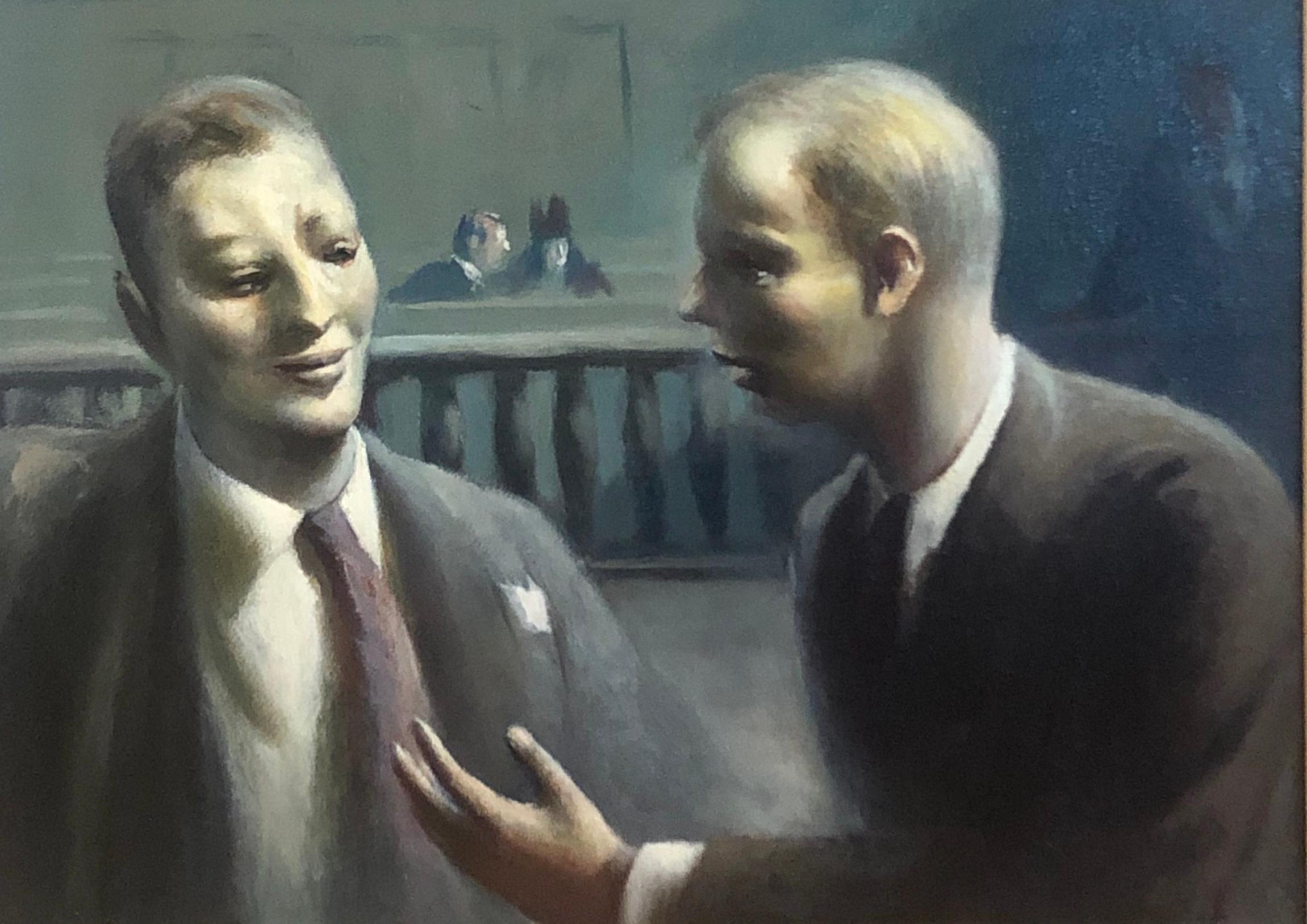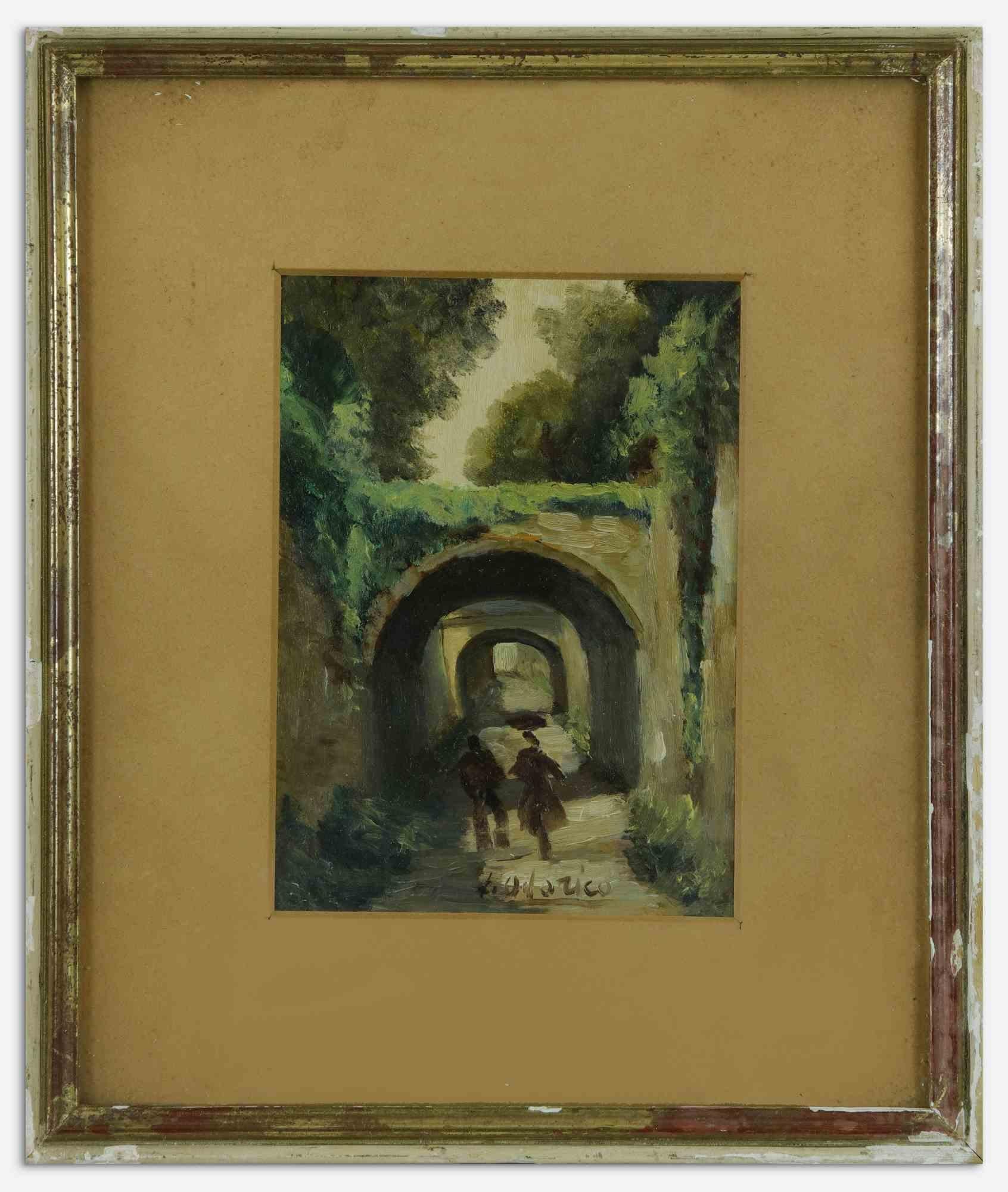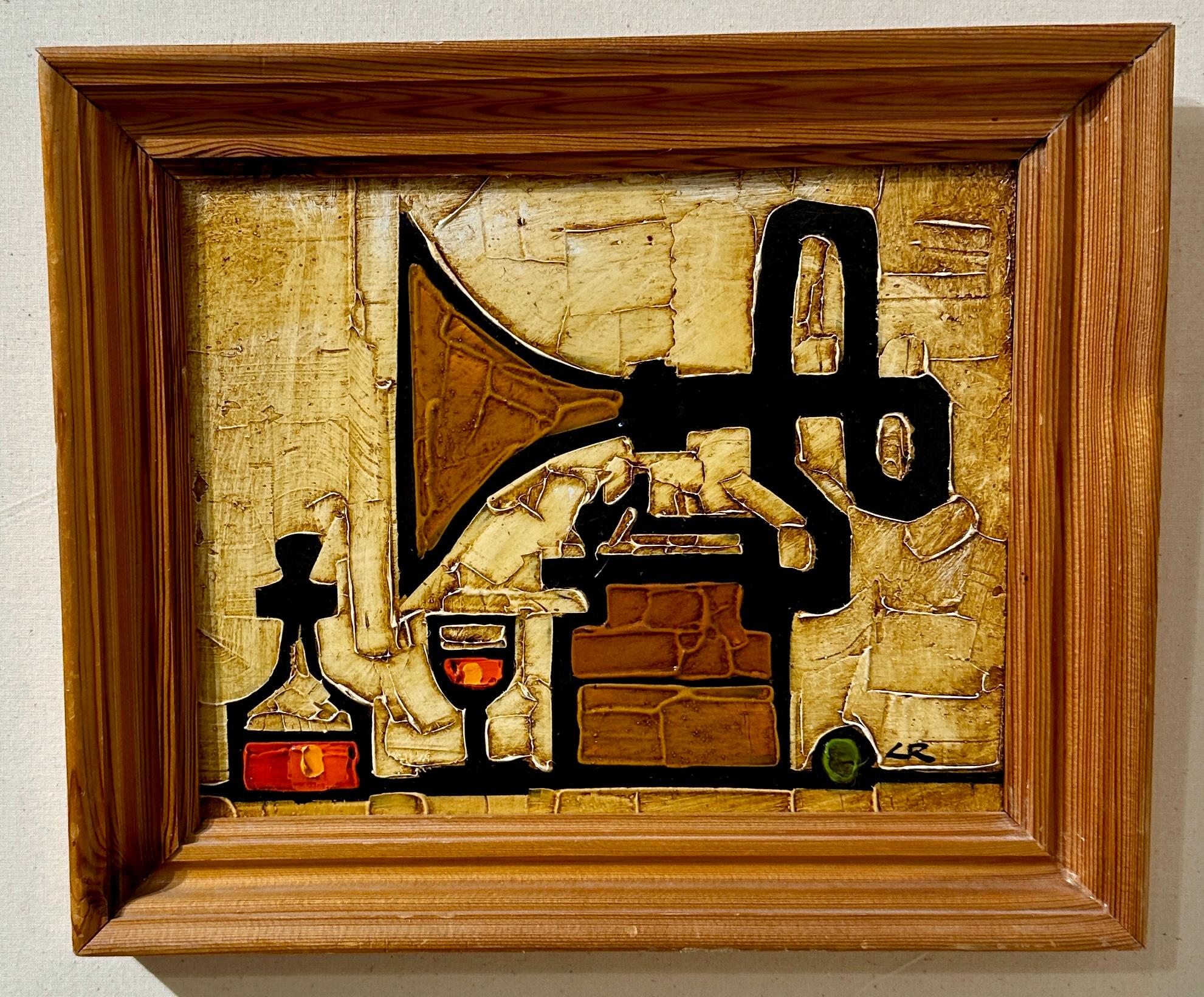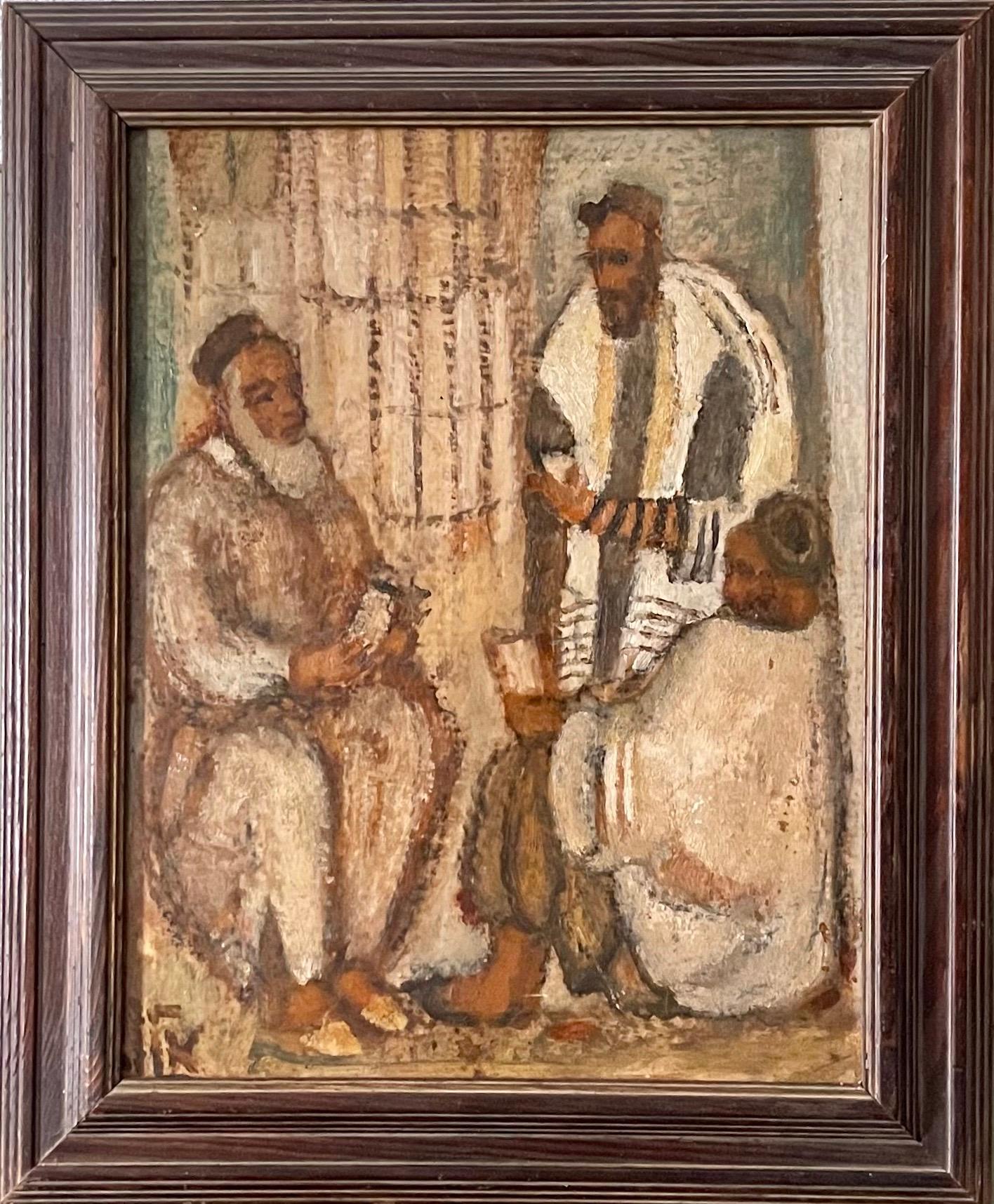Items Similar to Oil Painting Interior Scene Chair w Chinese Rug Joseph Solman American Art WPA
Want more images or videos?
Request additional images or videos from the seller
1 of 12
Joseph SolmanOil Painting Interior Scene Chair w Chinese Rug Joseph Solman American Art WPA
About the Item
Joseph Solman (1909-2008),
Chair with Chinese Rug,
oil paint on masonite, initialed JS on recto, titled and signed "J.S." verso,
Dimensions 14" x 10" Framed to 21 X 17
Provenance: William H. Trayes, Jr. art collection
Joseph Solman (January 25, 1909 – April 16, 2008) was a Jewish American painter, a founder of The Ten, a group of New York City Expressionist painters in the 1930s. His best known works include his "Subway Gouaches" depicting travellers on the New York City Subway.
Born in Vitebsk, Belarus, Russian Empire, he was brought to America from the Russian Empire as a child in 1912, Solman was a prodigious draftsman and knew, in his earliest teens, that he would be an artist. He went straight from high school to the National Academy of Design, though he says he learned more by sketching in the subway on the way back from school late at night: people "pose perfectly when they're asleep." In 1929, Solman saw the inaugural show at the Museum of Modern Art featuring Seurat, Gauguin, Van Gogh, and Cézanne.
In 1934, Solman had his first one-man show, much influenced by the French modern artist Georges Rouault. One critic was impressed by "the mystery that lurks in deserted streets in the late twilight." Another noted that Solman's color had "an astonishingly rich quality that burns outward beneath the surface."
Joseph Solman was, with Mark Rothko, the unofficial co-leader of The Ten, a group of expressionist painters including Louis Schanker, Adolph Gottlieb, Ben Zion and Ilya Bolotowsky, who exhibited as the "Whitney Dissenters" at the Mercury Galleries in New York City in 1938. The members, all immigrant Jewish New Yorkers with an interest in European Expressionism, presented an urban, abstract, formal style. A champion of modernism, Solman was elected an editor of Art Front Magazine when its other editors, art historian Meyer Schapiro and critic Harold Rosenberg, were still partial to Social Realism. But Solman never believed in abstraction for abstraction's sake. "I have long discovered for myself," Solman has said, "that what we call the subject yields more pattern, more poetry, more drama, greater abstract design and tension than any shapes we may invent." As his colleagues in the Ten advanced toward a more non-objective art, Solman warmed toward representation. An artist in the Works Project Administration (WPA) during the depression, Solman met and worked with and befriended many great artists, like Milton Avery. “Avery had a big influence on me when I was young and working in the WPA,” said Solman. “That was a great program, I couldn’t have worked without it. It’s where I saw Paul Klee’s work, which I liked very much.” By the early 1950s, when the Abstract Expressionism he had helped to develop was the mainstream in avant garde art, he was done with it. With Edward Hopper and Jack Levine, he began a magazine called "Reality." It featured the work of figurative painters, then terribly out of fashion, but its central editorial stance was that artists should be able to paint however and whatever they liked. In writing about a purchase of a typical 1930s Solman street scene for the Wichita Museum, director Howard Wooden put it this way: "Solman has produced the equivalent of an abstract expressionist painting a full decade before the abstract expressionist movement came to dominate the American art scene, but without abandoning identifiable forms." He was part of a group of New York mostly jewish artists that included Byron Browne, Milton Avery, Stuart Davis, Alice Neel, Max Weber, Ben Shahn and many others.
In 1964, The Times, discussing his well-known subway gouaches (done while commuting to his some-time job as a racetrack pari-mutuel clerk), called him a "Pari-Mutuel Picasso." In 1985, on the occasion of a 50-year retrospective, The Washington Post wrote: "It appears to have dawned, at last, on many collectors that this is art that has already stood the acid test of time.
- Creator:Joseph Solman (1909-2008, American)
- Dimensions:Height: 21 in (53.34 cm)Width: 17 in (43.18 cm)
- Medium:
- Movement & Style:
- Period:
- Condition:good. measurements include frame, mat and frame have wear and can use replacing.
- Gallery Location:Surfside, FL
- Reference Number:1stDibs: LU38214033612
About the Seller
4.9
Platinum Seller
These expertly vetted sellers are 1stDibs' most experienced sellers and are rated highest by our customers.
Established in 1995
1stDibs seller since 2014
1,547 sales on 1stDibs
Typical response time: 1 hour
- ShippingRetrieving quote...Ships From: Surfside, FL
- Return PolicyA return for this item may be initiated within 3 days of delivery.
More From This SellerView All
- Synagogue Interior Jerusalem Modernist Israeli Judaica Oil Painting Rabbi PrayerBy Arieh AllweilLocated in Surfside, FLARIEH ALLWEIL (ARIE ALWEIL) 1901-1967 Galicia 1901-1967 Safed, Israel (Ukrainian/Polish/Israeli) Arieh Allweil, born 1901, Galicia. Immigrated to Palestine in 1920. Studies: 1921-25 Art Academy, Vienna; Dresden Academy. Alweil brought with him the high values of the Central European avant-garde, which he had absorbed during his years of study in Vienna. He joined the ‘Kunstschau’ group- of artists that had formed around Gustav Klimt and Egon Schiele. He exhibited with them in the 1920’s, and emigrated to Palestine in 1926. He was one of the founders of the Tel Aviv Art Museum and the Midrasha Art Teachers College in Israel. As opposed to other modern Israeli artists in his period, Allweil's woodcuts and illustrations pertained to contemporary events such as the Holocaust and the pioneering spirit before the establishment of the State of Israel. Most notable is this work as well as the first illustrated Passover Haggada for the IDF which he made in 1950 and which was printed for 3 years with his inspirational woodcut illustrations. He published a series of linoleum cuts of Israeli and Biblical subjects and created large scale murals of the Holocaust. Teaching: In Israel, art. Prizes: Received Dizengoff Prize twice; 1955 Turov Prize for Bible Illustrations. Published series of linoleum cuts of Israeli and Biblical subjects, also illustrated a Passover Haggadah and large scale murals of Holocaust. From 1952 until his death lived in Tel Aviv and in Safed in summer. Died 1967, Safed. Education 1921-25 Art Academy, Vienna, Austria 1921-25 Dresden Academy, Germany Teaching Herzliyah Gymnasium High-School, Israel, art. Tel Aviv High School Awards And Prizes 1937 Dizengoff Prize for Painting and Sculpture, Tel Aviv Museum of Art, Municipality of Tel Aviv-Jaffa 1946 Dizengoff Prize 1955 Turov Prize for Bible Illustrations Select Solo Exhibition: 1933 Tel Aviv Museum, Solo Exhibition 1942 Katz Gallery, Tel Aviv 1950 Tel Aviv Museum, Tel Aviv 1956 The Blue Dome, Safed 1968 Memorial Exhibition of the artist Arieh Allweil Yad Labanim Museum, Petach-Tikva 1969 Solo Exhibition The Knesset, Jerusalem 1987 Arieh Allweil: 1901-1967 - ''Return to Betanya Ilit'' Beit Gabriel, Zemah 1994 Arieh Allweil: Prints and Calligraphy The Isaac Kaplan Old Yishuv Court Museum,Jerusalem 2011 Arieh Allweil, Letters, Figures, Landscapes Mishkan Le'omanut, Museum of Art, Kibbutz Ein Harod Select Group Exhibitions 1929 Eged - Palestine Painters Group Allenby Street, Tel Aviv Artists: ChanaOrloff, Abraham Melnikoff, Reuven Rubin, Nachum Gutman, Sionah Tagger, Arieh Allweil, Haim Gliksberg, Yossef Zaritsky, Leon Arie Fein, Pinchas Litvinovsky, Elias Newman. 1932 The Bezalel National Museum, Jerusalem Artists: Pinchas Litvinovsky, Gutman Nachum Allweil, Arieh 1936 First Exhibition of ''Hever Omanim'' Steimatzky Galleries, Jerusalem Artists: Gutman, Nahum Holzman, Shimshon Moshe Mokady, Miron Sima, Jakob Steinhardt, Zeev Ben Zvi, Moshe Ziffer...Category
20th Century Modern Figurative Paintings
MaterialsCanvas, Oil, Board
- Mid Century Hungarian Gilt Oil Painting on Board Modern JudaicaLocated in Surfside, FLFrom a collection by a long time Miami Beach art dealer on the old Lincoln Rd. This is a piece he brought back from hungary. from a collection of good Hungarian artists and Illustrat...Category
20th Century Modern Figurative Paintings
MaterialsOil, Board
- Blessing of the Tzadik (Rebbe) Rare Hungarian Judaica Oil PaintingBy Anton PeczelyLocated in Surfside, FLRare Pre World War II (Pre Holocaust) Judaica Art. European Judaic art from this period is exceedingly rare. Péczely Antal Anton 1891 - 1963 Known for his Jewish genre scenes, Chess scenes and other early 20th Century salon style paintings. In the tradition of Moritz Oppenheim...Category
Early 20th Century Post-Impressionist Figurative Paintings
MaterialsOil, Board
- Wisdom of King Solomon Rare Biblical Hungarian Judaica Oil PaintingBy Anton PeczelyLocated in Surfside, FLRare Pre World War II (Pre Holocaust) Judaica Art. European Judaic art from this period is exceedingly rare. Péczely Antal Anton 1891 - 1963 Known for his Jewish genre scenes, Chess scenes and other early 20th Century salon style paintings. In the tradition of Moritz Oppenheim...Category
Early 20th Century Post-Impressionist Figurative Paintings
MaterialsOil, Board
- Rare French, Paris 1935 Judaica Oil Painting Rabbis Studying S. FleischmanLocated in Surfside, FLRare Judaica Art. Jewish genre scene. In the tradition of Moritz Oppenheim, Isidor Kauffman and Maurycy Gottlieb and later of Tully Filmus, Zalman Kleinman and Itshak Holtz the artist captures this Jewish scene with a particular sensitivity. Part of the Ecole De Paris The term "School of Paris" was used in 1925 by André Warnod (fr) to refer to the many foreign-born artists who had migrated to Paris. School of Paris artists were progressively marginalized. Beginning in 1935 art publications no longer wrote about Marc Chagall, just magazines for Jewish audiences, and by June 1940 when the Vichy government took power, School of Paris artists could no longer exhibit in Paris at all. The artists working in Paris between World War I and World War II experimented with various styles including Cubism, Orphism, Surrealism and Dada. Foreign and French artists working in Paris included Jean Arp, Joan Miró, Constantin Brâncuși, Raoul Dufy, Tsuguharu Foujita, artists from Belarus like Michel Kikoine, Pinchus Kremegne, and Jacques Lipchitz, the Polish artist Marek Szwarc and others such as Russian-born prince Alexis Arapoff. A significant subset, the Jewish artists, came to be known as the Jewish School of Paris or the School of Montparnasse. The "core members were almost all Jews, and the resentment expressed toward them by French critics in the 1930s was unquestionably fueled by anti-Semitism." One account points to the 1924 Salon des Indépendants, which decided to separate the works of French-born artists from those by immigrants; in response critic Roger Allard (fr) referred to them as the School of Paris. Jewish members of the group included Emmanuel Mané-Katz, Chaim Soutine, Adolphe Féder, Chagall, Moïse Kisling, Maxa Nordau...Category
Mid-20th Century Post-Impressionist Figurative Paintings
MaterialsOil, Board
- Israeli Judaica Folk Art Oil Synagogue Interior Malkos Lashes Erev Yom kippurBy Yitzchak RomanLocated in Surfside, FLYitzchak Roman, Israeli Folk Artist Painting and sculpture, born in Safed, 1913, known for his naive depictions of Jewish life and biblical scenes...Category
20th Century Modern Figurative Paintings
MaterialsCanvas, Oil
You May Also Like
- "Tailor" WPA American Scene Social Realism Modernism Mid Century Modern FashionBy Mervin JulesLocated in New York, NY"Tailor" WPA American Scene Social Realism Modernism Mid Century Modern Fashion The board measures 9 1/2 x 15 1/2. Provenance: Mervin Jules Estate. Bio A painter, illustrator, pri...Category
1930s American Modern Figurative Paintings
MaterialsOil, Board
- "Naturaleza Muerta con Palomas", Alvar Sunol, Oil on Canvas, 51x32, ModernistBy Alvar Sunol Munoz-RamosLocated in Dallas, TX"Nautraleza Muerta Con Palomas" by Alvar Sunol is an original oil on board painting and measures 51x32. This painting incorporates Alvar's favorites drawing inspiration of mixing the...Category
Early 2000s Modern Figurative Paintings
MaterialsOil, Board
- Guy Pene du Bois WPA American Modernism Realism NYC Scene Oil Lawyers in CourtBy Guy Pène Du BoisLocated in New York, NYGuy Pene du Bois' "Two Figures in Courtroom" is a WPA era American scene oil painting created in a realistic style. Modernism at its best The work is framed by Heydenryk. Pène du Bois descended from French immigrants who settled in Louisiana in 1738 and was raised in a Creole household. He was born in 1884 in Brooklyn, NY and first studied with William Merritt Chase at the New York School of Art and later continued his training with Robert Henri. Pène du Bois was greatly impressed with Henri's credo that "real life" was subject matter for art and throughout his life a realist philosophy informed his art as well as his parallel career, art criticism. In 1905, Pène du Bois made his first visit to Paris where he painted scenes of fashionable people in cafes rendered in the dark tonalities and impasto associated with the Ashcan School. By 1920, he had achieved his mature style, which was characterized by stylized, rounded, almost sculptural figures painted with invisible brushstrokes. The subjects of his paintings were often members of society whom he gently satirized. In 1924, Pène du Bois and his wife, Floy, left for France where they would remain until 1930. Returning to America showcases pictures the artist produced after this very productive period abroad. After five years of living in France, Pène du Bois was able to observe American life with fresh eyes. His work becomes more psychologically intense and less satirical. In Girl at Table a slender, blond is shown gazing at a small statue that she holds at arm's distance. The meaning is elusive, but a powerful sense of longing is evoked. Similarly, paintings such as Dramatic Moment and Jane are taut with unresolved dialogue. Both pictures depict mysterious interiors in which a lone woman anxiously awaits the denouement of a suspenseful scene. Other pictures, for example, Chess Tables, Washington Square and Bar, New Orleans, recall Pene du Bois's Ashcan origins in their depiction of urban entertainment. During this period, landscape becomes an important subject for Pène du Bois. Girl Sketching...Category
1930s American Modern Figurative Paintings
MaterialsPaper, Oil, Board
- Into the tunnel - Oil Painting by Isidore Odorico - Early-20th CenturyLocated in Roma, ITInto the tunnel is an original modern artwork realized by Isidore Odorico (1893-1945) in the early 20th Century. Oil on board. Hand signed on the lower margin. Includes frameCategory
Early 20th Century Modern Interior Paintings
MaterialsOil, Board
- Modern British, Interior with an old record player, port decanter and glassLocated in Woodbury, CTColin Ruffell is an English painter of interiors, cityscapes, and many other unique subjects. His styles have varied and include iconic cityscapes of London, New York, Venice, Hong ...Category
1970s Modern Interior Paintings
MaterialsBoard, Oil
- "Cafe Mobile", Alvar Sunol, Oil on Board, 29x29, Romanesque Modernist, RedBy Alvar Sunol Munoz-RamosLocated in Dallas, TX"Cafe Mobile" by Alvar Sunol is an original oil on board painting and measures 29x29. This painting incorporates Alvar's favorites drawing inspiration of mixing the old with the new, the masters, such as Picasso, still lifes...Category
2010s Modern Figurative Paintings
MaterialsOil, Board





